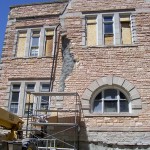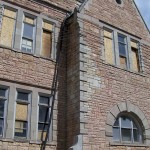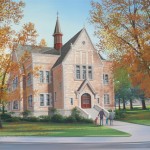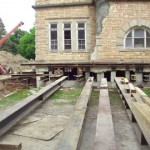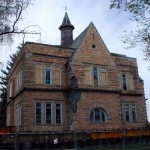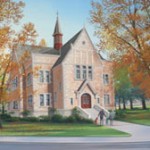Oneida Stake Academy, Preston, Idaho
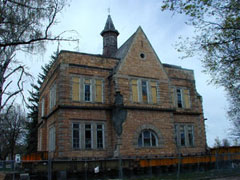
Photo courtesy: Alan Smith.
The Mormon Historic Sites Foundation helped raise the money necessary, $1.3 million, to allow the moving of the Academy. The Academy was moved to Benson Park in November 2003 to land donated by The Church of Jesus Christ of Latter-day Saints.
Currently, the Mormon Historic Sites Foundation and the Oneida Stake Academy Foundation are gathering donations to allow the restoration of the Academy.
Beginning with the establishment of the Brigham Young Academy in Provo in 1875, the Church developed a series of academies in a corridor from Canada to Mexico to address the educational needs of Church members. In the 1880s, with the Edmunds-Tucker Act pending legal review by the Supreme Court, and with the influence of the federal government on the rise, religious training was effectively excluded from the public schools.
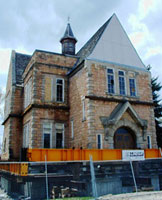
In 1888, Wilford Woodruff, Chairman of the Church Board of Education, wrote to all LDS stakes, including the Oneida Stake in southern Idaho, counseling formation of a stake board of education and decreeing it was “the duty of these boards to take into consideration the formation of church schools.”
The Saints in the Oneida Stake in Preston, Idaho, responded financially, and plans for an attractive academy building to be constructed of cut stone were prepared by Church Architect Don Carlos Smith. Male members of the stake were called on missions to quarry and haul the stone. Construction on the building was completed and the Academy dedicated by Elder Moses Thatcher of the Quorum of the Twelve on 28 July 1895.
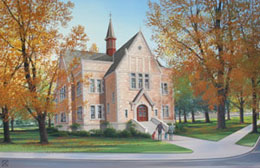
In the 1950s, the local high school was constructed just a few feet from the academy building, blocking its view from the street, and necessitating the removal of its original entrance steps. The academy has had its friends over the years who have attended to and preserved the building in a reasonable condition while hidden behind the high school. The Preston School Board decided that it must expand into the space occupied by the building and announced that it must either be moved or it would be demolished in the spring of 2003.
Photos
Articles & Resources
Press Release
Author(s): Necia Seamons
Published in:
Publication Date: October 27, 2005
Press Release
October 27, 2005
Necia P. Seamons
Members of the Oneida Stake Academy Foundation (OSAF) continue to collect funds granted to the restoration of the Oneida Stake Academy. At the same time restorative construction proceeds on the 115-year-old school.
Months of planning and effort to obtain easements for power and telephone service to the academy have finally concluded with a decision to run utilities in the public easement along Oneida. Scott Rawlings has been hired to install power and telephone service to the building. On site work began last week.
Rawlings expects the power to be to the building by the end of this week.
In addition to installation of power to the building, the OSAF and Mormon Historic Sites Foundation (MHSF) intend to contract with Keith McKay, stone mason over the construction of the Nauvoo Temple of The Church of Jesus Christ of Latter-day Saints, to repair and replace the stonework as needed on the academy.
McKay spent months obtaining permission to extract the stone he needs for the project from the original quarry, which lies east of Franklin.
Permission was finally granted from the Stockdale Family Trust, which owns the land, and the required state agencies last week.
McKay, whose operations are located throughout the west, will quarry all the stone needed for the complete restoration of the academy in the next few weeks. The stone will be stored at his operation in Murray, or carved at his plant in Torrey, Utah, until it is needed.
His first efforts will be to repair the broken corner on the academy’s southeast corner. When that is done, seismic upgrading will begin, said project architect, Joseph Linton.
Structural Solutions, of Logan, Utah, has engineered a plan to upgrade the seismic capabilities of the academy. A-Core, Inc., which is presently doing the core drilling on the Salt Lake Tabernacle and the Utah State Capitol, will core drill the walls and fill them with the rebar and grout, as soon as the stonework is finished.
As funds come in, McKay will also face the academy’s concrete foundation with stone and replace the parapets that originally lined the building’s roofline.
Although most grants and donations have been collected, significant amounts have not been released to the OSAF and MHSF, which has halted progress on the academy. OSAF board members hope to have those funds collected soon.
The board was recently notified that the project is under consideration for almost $500,000 in additional grant monies. Final notification is expected in November.
Oneida Stake Academy restoration takes step forward with The Church of Jesus Christ of Latter Day Saints
Author(s): Necia Seamons
Published in: Preston Citizen
Publication Date: April 27, 2005
Published on April 27, 2005. Reprinted with permission from the Preston Citizen.
Oneida Stake Academy restoration takes step forward with The Church of Jesus Christ of Latter-day Saints Foundation contribution
Necia P. Seamons, Citizen staff writer
The restoration of the Oneida Stake Academy took a large step forward today with a generous contribution from the Church of Jesus Christ of Latter-day Saints Foundation, said Fred Woods of the Mormon Historic Sites Foundation.
An ample gift from the same foundation two years ago helped with the historic move of the academy from its original site to its new location in Benson Park in Preston. The lot on which the building now sits was another gift from the Church to the restoration of the 115-year-old Oneida Stake Academy. The park is named after the family of Ezra Taft Benson, former president of The Church of Jesus Christ of Latter-day Saints.
Benson was raised just east of the City of Preston in Whitney.
He attended the Oneida Stake Academy and graduated in 1919, a year after his friend Harold B. Lee, another president of The Church of Jesus Christ of Latter-day Saints.
According to a biography of Benson by Sheri L. Dew, Benson and Lee shared a lifelong friendship that began during their school days at the Oneida Stake Academy. They then spent many years working together as general authorities of the Church.
While a student at Preston High, Benson studied and was involved in agricultural, academics, carpentry and basketball.
“From Harrison Merrill, …from Cub River, he acquired a love of literature
– poetry in particular. … He crafted a cupboard and table, an oak desk with shelves on either side and a hat rack, and was ‘quite proud’ of himself,” states the biography.
Benson played the trombone and sang in the school’s first choir with Lee, who grew up in Clifton.
“The Oneida,” which is the 1916 commencement publication for the academy, listed Lee as an athletic manager, a comedian, debater and vice president of his class. At a graduating celebration held by the class of 1916, “the genius” Lee rendered “a few excellent piano selections,” states “The Oneida.”
Benson, Lee and hundreds of other young men and women appreciated the education they were offered at the Academy at a time when attending school was not as convenient as it is in present times.
“There is a standard of ideals in the Oneida Academy which inspires one on entering to look his best, act his best and be his best. And it is our association with each other under this influence that we have acquired much,” states a passage in “The Oneida.” Such was the value placed on education at the Oneida Stake Academy.
The Mormon Historic Sites Foundation and the Oneida Stake Academy Foundation invite continued financial support for the restoration of the academy.
Once restored, it will serve as a cultural center to the community. The elegant top floor ballroom will be available for wedding receptions, banquets, reunions, concerts, and conventions. The main floor will house a welcome center, museum of local history, and turn-of-the-century classroom/historical library. The basement will house another meeting room, food services, professional offices and dressing rooms. A large staircase/balcony and courtyard in back will accommodate outdoor concerts and theatrical productions.
An elevator will provide handicap accessibility to all levels of the academy and the academy’s exterior will be restored to its original condition, as well. Fees generated by use of the facilities and visiting tourists will generate maintenance funds and boost the economy of Franklin County.
To support the restoration, interested persons should send donations to the Mormon Historic Sites Foundation, P.O. Box 555, Preston, Idaho 83263.
For more information call 208-852-1837, or 801-607-1073.
Life on the River
Author(s): Carma Wadley
Published in: Deseret Morning News
Publication Date: February 4, 2005
Published February 4, 2005. Reprinted with permission from the LDS Church News published by the Deseret Morning News.
Life on the river
Bear River Heritage Area aims to promote tourism, preserve culture
Carma Wadley, Deseret Morning News
Were geography and geology not what they are, the Bear River could make its journey from headwaters in the Uinta Mountains to its endpoint in the Great Salt Lake in about 90 miles.

As it is, however, the river makes a 500-mile loop through three states. But that journey brings great benefits, as the water carves out habitats for birds and wildlife, allows for irrigation and agriculture and supplies hydroelectric power for towns and cities.
From the earliest times, the convergence of these benefits has created an area that is rich, diverse and unique, said Elaine Thatcher, associate director of the Mountain West Center at Utah State University and chairwoman of the board of the Bear River Heritage Area. BRHA is an association that brings together seven counties in both Utah (Box Elder, Cache and Rich) and Idaho (Bear Lake, Franklin, Caribou and Oneida) to promote economic development and tourism while preserving local culture.
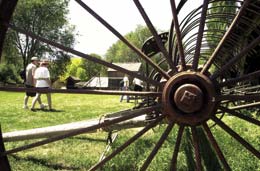
It brings together county commissions, mayors, business people, folklorists, artisans and others, said Thatcher, “to look at what the region needs but to see what of value we need to hang on to. So often economic development destroys local culture. But we have a unique area, and we want to keep it that way.”
Cindy Hall, community and economic director for the Bear River Association of Governments, agrees. “We have initiatives to help local businesses, and we see heritage tourism as an important way to do that. We want to celebrate who we are.”
BRHA has recently produced a guide book to the area, which lists a number of heritage sites, experiences, products, foods, lodging, festivals and other attractions within the region. The group is now working on a Web site (www.bearriverheritage.com).
The Bear River watershed area sits in one of the driest parts of North America, said Thatcher. Yet, because of the river, it is greener than its surroundings, and through the centuries it has offered a hospitable home to both people and wildlife. BRHA calls it an area “blessed by water, worked by hand.”
Early Shoshone tribes, who called the Bear River “bia oroi” or “big river,” wandered about the area, following the seasons. In the early 1800s, fur traders and trappers came to the area to rendezvous and cache their supplies. The Oregon Trail brought thousands of immigrants through the region. And after the Mormon pioneers came to the Salt Lake Valley in 1847, settlers began moving north to stay. The first permanent settlement was Wellsville, established in 1856.
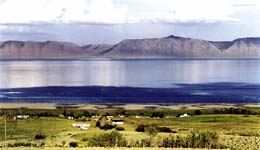
On May 10, 1869, the transcontinental railroad was completed at Promontory, Utah, and both people and freight began to arrive on a regular basis.
The heritage of the area still shows in its landscape, people, economy and culture, said Thatcher. People might look at it, she said, and think there’s nothing different here. “But if you look closer, there really is. What is unique is the way the history and culture interact, and the way they have transitioned to contemporary culture.”
That includes not only historical buildings and towns but also the landscapes, the barns, the people who create products everything from chainsaw bears to rawhide and saddles, to chocolates and honey.
These are all part of the heritage, said Thatcher, and are reasons to visit the area. “Heritage tourism is very popular. If you look at the numbers, they are staggering. Heritage tourism to visit a cultural or historic site is the No. 1 reason Americans give for traveling. Ecotourism is No. 3, and this area, with its fishing and camping and canyons, is rich in that as well.”
In general, she said, heritage tourists have a higher income, stay longer and spend more. “So they are desirable to bring in as long as it is controlled so an area doesn’t get too beloved and get trampled to death,” she said.
Thatcher recently visited a travel show in Los Angeles “the first time we’ve started to promote outside our area” and was pleasantly surprised at the number of people who like to take road trips who like to get in their cars and drive and discover unusual things.
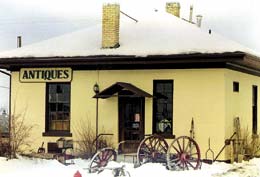
“That’s exactly what we have here. We have some fairly great distances, but we have some wonderful little treasures, if you know where to find them.”
Three sites are considered anchors, she said: The American West Heritage Center in Wellsville, the Golden Spike National Historic Site west of Brigham City, and the Oregon Trail Center in Montpelier.
“The Oneida Stake Academy in Preston may grow into another anchor site for us,” said Thatcher. “That has been an amazing project.” The academy building was threatened with destruction, but local citizens rallied and were able to move it to a park site. “It’s one of the last remaining academy buildings in the Mormon West.”
In order to produce the guide, folklore students went into the field to find out what was unique about each area. “They gathered information on orcharding and ethnic groups and phosphate mining,” said Thatcher. Bear Lake offers recreation possibilities, “but we also talk about the Bear Lake Monster and the raspberries. The quirky facts � such as the leg buried in a cemetery in Samaria � are as fun as the serious history.”
They identified nine cultural themes that can be used to develop products, tours and activities: natural resources, agriculture, local businesses and institutions, ethnic and cultural groups, domestic and community landscapes, independence and self-sufficiency, community celebrations, and history. “We drew a very large circle, but it’s more inclusive than exclusive.”

BRHA is similar to initiatives that have developed along Highway 89 in southern Utah, she said. “We’re all part of the Utah Heritage Industry Alliance, which includes This Is the Place Heritage Park and the Four Corners area and others. We all talk with one another and learn from one another.”
Their ultimate goal, said Thatcher, is to get national heritage status for the area. “That has to be done by an act of Congress and is a long drawn-out process.”
What makes the Bear River area worth visiting? History, beauty, diversity, activity and more, said Hall. “Our pastoral landscapes. Our open vistas. Our agricultural lifestyle. Our walkable downtowns. Our historic buildings. Our Band of Northwestern Shoshone. Our hot springs. Our birds. Our family diners. Our B&Bs. Our artisans. There are so many resources, and we need to promote and protect them.”
Congressman Simpson Secures Additional $150,000 for Oneida Stake Academy Project
Author(s): Necia P. Seamons
Published in: Preston Citizen
Publication Date: August 4, 2004
Reprinted with permission from the Preston Citizen.
Congressman Simpson Secures Additional $150,000 for Oneida Stake Academy Project
Necia P. Seamons, Citizen staff writer
A $150,000 grant for the Oneida Stake Academy was just approved by the Idaho Congressional Delegation.
“We appreciate the support of Congressman Mike Simpson. These funds will not only help us with the restoration of the building, but in our efforts to raise the rest of the $2.7 million needed to restore the Oneida Stake Academy to its former glory,” said Doug West, of the Oneida Stake Academy Foundation.
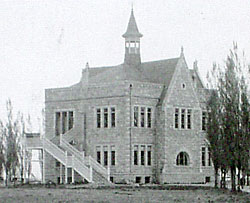
“For all the competing priorities Congressman Simpson has in the state of Idaho, it is a real honor for Franklin County for him recognize the value of the academy and to get it funded,” said Elliott Larsen, another member of the OSAF.
“The Franklin County Commissioners have been great in recognizing the impact the federal appropriations process can have in a small county such as our community,” he said.
The grant brings the federal appropriations for this project to $450,000, as Congressman Simpson announced a $300,000 grant to the project in July 2003.
The funds will be directed to the academy from the Housing and Urban Development’s Economic Development Initiative Grant program. The program is designed to help under-served communities on a variety of community improvements and economic development.
“We invite not only those people capable of helping us with large grants, but individuals capable of any donation, small or large, to join us in this campaign to make the academy a part of our community again. We hope anyone who ever attended or taught in a class in that building will contribute to this exciting project,” said West.
All classes of Preston High School are invited to participate in a contest to raise the most funds for the academy’s renovation. The class which donates the largest amount will be offered use of the building for their high school reunion at no charge.
The new foundation on the academy is nearly complete, with all outside walls formed and damp-proofed. Lynn and Stuart Burbank installed a French drain around the building’s footings and Christensen Sand & Gravel back-filled the hole to grade on three sides of the building.
The back will be left open to accommodate a future courtyard.
The next step in the restoration of the academy is to clean out the old ceilings and other debris in the basement and first floors to prepare the building for structural stabilization.
“We need to develop a shear connection between each floor as well as on the exterior and interior stone walls,” said Joseph Linton, architect for the Oneida Stake Academy Foundation. An engineer is presently working out the details on the method to do so.
Temporary closures will be also be placed in open windows to secure and allow for temperature control within the building.
“Once the building has been structurally stabilized, we will proceed with the restoration of the interior and exterior of the building,” Linton said.
Orchid Award
Author(s): Necia P. Seamons
Published in: Preston Citizen
Publication Date: June 4, 2004
Orchid Award
Necia P. Seamons
The Oneida Stake Academy Foundation and the Mormon Historic Sites Foundation were both awarded a Friend of Preservation award on May 22, as part of Preservation Idaho’s 27th annual presentation of their Orchid and Onion Awards.
The award was given “in recognition of superlative achievement in preserving Idaho’s heritage,” it states.
The foundations worked together to save the 114-year-old Oneida Stake Academy from destruction and move it to Benson Park in Preston, last year. They continue to work together to restore the building for public use. The foundations were nominated by Jerry Myers, an architect in Pocatello and Idaho Advisor for the National Trust for Historic Preservation.
Preservation Idaho, also known as the Idaho Historic Preservation Council, was organized over 30 years ago “by a group of Idahoans concerned with the alarming rate at which historic sites and resources in Idaho were big lost,” states their website, www.preservationidaho.org. Today, that group has grown to 250 individuals, corporations and foundations. It promotes not only preservation of, but education in Idaho’s heritage.
“With mounting pressure from development and a continuously growing and changing population in the state, it is now more necessary than ever to preserve historic and cultural resources, to promote the smart re-use of historic facilities and to educate the community-at-large of the value of Idaho heritage,” states the web site.
The Orchid and Onion awards are intended to recognize individuals and organizations that make positive contributions to historic preservation in Idaho and to bring awareness to projects and organizations which are insensitive to historic preservation, states Bruce Poe, president of Preservation Idaho.
The ceremony was held in Boise. Representing the Oneida Stake Academy Foundation was Elliott Larsen, secretary/treasurer, and representing the Mormon Historic Sites Foundation was Fred Woods, executive director.
“We are thrilled with the award. Getting the recognition of this statewide organization just substantiates what we’ve known all along, that the academy is a significant historical landmark in Southeastern Idaho,” said Larsen. “Preserving it tells a story of our pioneer ancestors; it provides a link from our past to us to our future generations. Things like this do need to be preserved.”
Oneida Academy may face demolition soon
Author(s): Carrie A. Moore
Published in: Deseret Morning News
Publication Date: May 30, 2004
Published May 30, 2003. Reprinted with permission from the Deseret Morning News.
Oneida Academy may face demolition soon
Carrie A. Moore, Deseret News religion editor
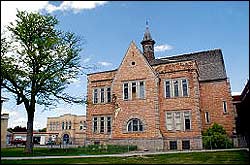
Jeremy Harmon, for the Deseret News
One of the only remaining LDS academy buildings still standing will face the wrecking ball in the next few weeks if money can’t be found to save it by mid-June.
The Oneida Stake Academy in Preston, Idaho, has been the focus of fund-raising efforts for at least two years, but to date the $1.2 million needed to move it from its present location hasn’t been raised. The building stands within just a few feet of Preston High School, whose growing student population needs additional space to grow.
After months of discussion among locals about the building’s future, and a series of deadlines for fund raising having come and gone, the Preston School Board decided Wednesday night to solicit bids for demolition. The board plans to award a contract to the winning contractor on June 18.
Necia Seamons, a Preston resident who has helped spearhead efforts to save the building, said if her preservation group Friends of the Academy has a signed contract with a Washington state moving company to relocate the building by June 18, the school board will stay the wrecking ball.
Otherwise, “the ax is falling. If people are going to help us, they have to help us now because we’re at the end of our rope.”
To date, more than 250 people have donated to save the building, giving anywhere from $5 to $250,000. The latter amount was donated by Utah Jazz owner Larry H. Miller and his wife, Gail, earlier this year. Gail Miller has ties with Franklin County.
With $650,000 already in the bank, the group needs another $500,000 immediately to move the building three blocks so it can be restored. Restoration will cost another $1.3 million, Seamons said, but she is confident the additional funds can be raised.
Built from 1890-1894 by German immigrant John Nuffer at a cost of between $20,000 and $40,000, it was one of several schools constructed by early members of The Church of Jesus Christ of Latter-day Saints. It is believed to be the oldest of 35 such academies the church built from 1888 to 1909 at scattered locations around Utah, Idaho, Wyoming, Arizona, Mexico and Canada. The academies were forerunners to the Church Educational System and seminary program, designed to provide students with both a spiritual foundation and secular training.
Until 1922 the Oneida Academy served as a combination high school and church academy for hundreds of high-school-age students. Two of its graduates later served as presidents of the LDS Church: Harold B. Lee and Ezra Taft Benson, the latter of whom was U.S. secretary of agriculture under President Dwight D. Eisenhower.
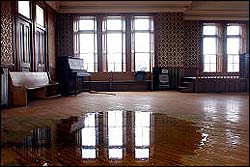
Jeremy Harmon, for the Deseret News
Fred Woods, associate professor of religion at Brigham Young University and executive director of the Mormon Historic Sites Foundation, said his group has been working with Friends of the Academy and believes “it’s going to be saved at the 11th hour.” Even as school board members were voting to accept bids for demolition, two private foundations are looking at how they can help save the building. “Right now I think one is looking at the other to see what’s going to happen.”
Woods, who has written a paper on the history of the building, found a journal entry from former academy faculty member Joseph G. Nelson, who wrote of those who attended: “Pages could be filled with experiences of how these roughhewn diamond boys from the cattle ranches and the farms, and girls whose unsophistication (sic) in social affairs . . . were transformed into fine cultured students . . . and from this group Bishops, Counselors, Mayors and County and State officials were chosen in later years.”
From 1922 until 1990, the building was used by the local school district. In 1977, it was placed on the National Register of Historic Places. Seamons said Utahns can appreciate what can be done with such old buildings if they have visited the Brigham Young Academy in Provo. Preservationists tried for years to raise money for that structure, and nearly lost it to demolition before it was finally restored.
If the money is raised to move the 1,800-ton building, it will literally be sawed off its foundation and pushed onto a giant rolling platform that will inch its way down the street to Benson Park, which has been offered by the LDS Church as a permanent home. There, supporters believe it can be refurbished and become a self-supporting community cultural center. The local Chamber of Commerce has signed a letter of intent to inhabit the building and help arrange for community functions and tourist promotion.
The Forgotten Voice of the Oneida Stake Academy
Author(s): Fred E. Woods
Published in: Mormon Historical Studies
Publication Date: Spring 2003
Harold B. Lee’s Reminiscence of the Oneida Stake Academy
Published in: Site & Scene
Publication Date: Fall 2002
Site and Scene
Volume 4, Number 1
Fall 2002
Harold B. Lee‘s Reminiscence of the Oneida Stake Academy
In the fall of 1912, I entered the Oneida Stake Academy at the age of thirteen years. Mother had not yet permitted me to wear long pants, and when I entered high school I was the youngest of the class and was one of the only two in school who were wearing knee pants.
When I entered school I was anxious to continue my music training. The high school band offered the best opportunity. My first instruments were an alto [saxophone] and the French horn. . . .
In my second year at high school I became acquainted with Ethel Cole of Fairview, Idaho, and during our high school years and until I went on my mission in 1920, she and I kept up a rather constant, intimate friendship either by correspondence or by occasional visits. I remember her as my first sweetheart and the only girl with whom I kept steady company prior to my mission. I always admired her as a genuine friend.
In my senior year in high school, 1915-16, I was extremely busy with a number of school activities outside of my school work. One of my debating teammates was Sparrel Huff. The Oneida Academy was in a league with the Fielding Academy of Paris, Idaho, and the subject to be debated was, Resolved: That the Monroe Doctrine should be abolished. We defended the negative side and Lewis Ballif and Irel Lowe the affirmative. Prior to the finals with the Paris teams, we staged debates all over the adjoining counties.
Never in the history of our school had a team won . . . [against the] Fielding Academy at Paris, but we succeeded in turning the tables in a thrilling two-to-one decision over a Paris team, composed of Nellie Parker and George Bateman. They gave us a banquet following the debate, and the next day we return to Preston as conquering heroes, where our home team was victorious and our student body gave us our real reception in a special assembly.
My favorite sport was basketball, and at the time I attended high school it was the major athletic sport. In my junior year I was elected athletic reporter for the Oneida, the school paper; and in my senior year, I was elected the student manager of athletics, which was the plum of all school offices because it carried the privilege of accompanying all athletic teams on their trips to handle the business affairs while en route, all expenses being paid by the school. Art Rynearson was the coach, and we were fortunate in having a team that competed on even terms with college teams like the UAC [Utah State Agricultural College in Logan]. Our team played games that took us from Rexburg, Idaho, on the north to Ogden, Utah, on the south. It was often my responsibility, also, to scout rival teams.
Besides managing the team, I gained considerable skill as a player. I was a member of the senior team that won the class championship. Following my graduation I continued to play and enjoyed some reputation as a basketball player.
In the graduating class there were but five girls and twenty-five boys; a great bunch of fellows. On the night of Founders Day we climbed to the top of the flag pole over the Academy and nailed our class colors, and then each in turn climbed to the flag and kissed the colors. After singing and giving class yells we retired to our rooms, and awoke in the morning to discover that during the night our colors were taken down by the junior class. A grand fight followed which was finally stopped by the officers. (Harold B. Lee, Autobiography, in L. Brent Goates, Harold B. Lee, Prophet and Seer [Salt Lake City: Bookcraft, 1985], 46-48.)
Mormon Historic Sites Foundation Spearheading Efforts to Save and Restore the Oneida Stake Academy
Author(s): Kim R. Wilson
Published in: Preston Citizen
Publication Date: Fall 2002
Site and Scene
Volume 4, Number 1
Fall 2002
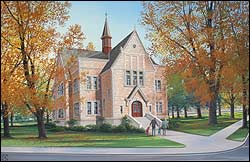
Mormon Historic Sites Foundation Spearheading Efforts to Save and Restore the Oneida Stake Academy
Kim R. Wilson
Chairman, Mormon Historic Sites Foundation
Beginning with the establishment of the Brigham Young Academy in Provo in 1875, the Church developed a series of academies in a corridor from Canada to Mexico to address the educational needs of Church members. In the 1880s, with the Edmunds-Tucker Act pending legal review by the Supreme Court, and with the influence of the federal government on the rise, religious training was effectively excluded from the public schools.
In 1888, Wilford Woodruff, Chairman of the Church Board of Education, wrote to all LDS stakes, including the Oneida Stake in southern Idaho, counseling formation of a stake board of education and decreeing it was the duty of these boards to take into consideration the formation of church schools.
The Saints in the Oneida Stake in Preston, Idaho, responded financially, and plans for an attractive academy building to be constructed of cut stone were prepared by Church Architect Don Carlos Smith. Male members of the stake were called on missions to quarry and haul the stone. Construction on the building was completed and the Academy dedicated by Elder Moses Thatcher of the Quorum of the Twelve on 28 July 1895.
The Oneida Stake Academy has many distinguished alumni who have had an immeasurable influence on the Church including LDS Church presidents Harold B. Lee and Ezra Taft Benson. (See Harold B. Lee’s reminiscences on page 6.)
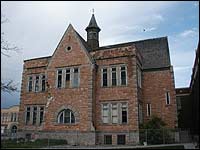
The building is beautifully architected and skillfully crafted and stands today in reasonably good condition. It has classrooms on the main floor and a meeting room on the upper level with a majestic vaulted ceiling and skillfully crafted woodwork.
In the 1950s, the local high school was constructed just a few feet from the academy building, blocking its view from the street, and necessitating the removal of its original entrance steps. The academy has had its friends over the years who have attended to and preserved the building in a reasonable condition while hidden behind the high school. But the Oneida Academy, one of only two remaining original Church academy buildings, may be in the last months of existence. The Preston School Board has decided that it must expand into the space presently occupied by the building and has announced that it must either be moved or it will be demolished in the spring of 2003.
With funding by the Mormon Historic Sites Foundation, a comprehensive architectural feasibility study has been completed and bids have been solicited from two national firms deemed capable of moving the 1,800-ton masonry structure. The Church has agreed to make available a portion of the Benson Park on Oneida Street in Preston at no cost to receive the structure. However, the cost of renovation will be approximately $1,000,000, and the cost of moving this unique structure two city blocks to its new home are in excess of $1,100,000. Excavation and a new foundation to support this substantial structure will be approximately $300,000, putting the cost of the completed project at approximately $2,500,000.
Friends of the Academy, a community-based volunteer group with whom the Mormon Historic Sites Foundation is working, has secured approximately ten percent of the amount needed. This is the most time-critical project with which the Foundation has been associated. Substantial donations to this unique project will be gratefully received.
LDS Foundation makes pledge
Author(s): Necia P. Seamons
Published in: Preston Citizen
Reprinted with permission from the Preston Citizen.
LDS Foundation Makes Pledge
Necia P. Seamons, Citizen staff writer
The Church of Jesus Christ of Latter-day Saints Foundation has joined several other people and organizations who recognize the value of the Oneida Stake Academy in Preston, Idaho. It has made a financial contribution to help move the academy to a new site.
A separate entity, The Church of Jesus Christ of Latter-day Saints, had already agreed that if the building can be moved and restored, it would donate land in the Preston Benson Park as a new location for the 113 year-old academy.
“We are grateful for the support of the men who approved this contribution,” said Fred Woods, executive director of the Mormon Historic Sites Foundation, who applied for the grant.
The academy was built by local pioneers in response to educational needs of their children. Notable graduates of its program were LDS presidents Ezra Taft Benson and Harold B. Lee, who were classmates, and famed FBI agent, Samuel Cowley. Benson was also the United States Secretary of Agriculture from 1952 to 1961.
Not only is it of great historical value, but it is of unique architectural design. It was built under the direction of John Nuffer, a castle builder from Germany, in the late 19th Century.
The grant from the LDS Foundation will bring the amount of money raised for the project to just over a $650,000. Preliminary bids placed the cost of moving the building at $1.2 million and $1.3 million to restore it for use.
The academy must be moved from its present location behind Preston High School to make way for new school construction. If it is not moved this summer, the school district will raze the academy to make room for a new high school cafeteria and library.
To help raise funds still needed to save the academy from the wrecking ball, interested persons can contact Woods at 801-607-1073, or any member of the Friends of the Academy: Doug West, Elliott Larsen, Leo Geddes, Joseph Linton, Beverly Hart, Lynn Womack, Dave Mitchell, Necia Seamons, Debbie Heaton, Lynene Larsen, and Dav Frew, all of Preston.
Donations may be sent to Mormon Historic Sites Foundation, P.O. Box 45000, Salt Lake City, Utah, 84145.
Pledges may be sent to Mormon Historic Sites Foundation – Oneida Stake Academy, P.O. Box 555, Preston, Idaho 83263.
$100,000 donation allows contract to be signed
Author(s): Necia P. Seamons
Published in: Preston Citizen
Reprinted with permission from the Preston Citizen.
$100,000 Donation Allows Contract to be Signed, Donations Reach $1 Million
Necia P. Seamons, Citizen staff writer
The Friends of the Academy and the Mormon Historic Sites Foundation were able to reach an agreement in principle with Lindsay Moving & Rigging, of Washington, to relocate the Oneida Stake Academy from its present site behind Preston High School, to Benson Park, in Preston, Idaho. Once there, the building will be restored for public use.
With a gift in excess of $100,000 from Gail Tanner Heiner late last week, the groups had received sufficient resources and commitments to meet the contract with the mover.
An agreement has also been made in principle with the member sof the Presiding Bishopric of the Church of Jesus Christ of Latter-day Saints, owner of the property onto which the academy will be relocated, to place the 113-year-old academy there. The Church said it will maintain ownership of the property for the present time, said Kim Wilson, president of the Mormon Historic Sites Foundation.
It is anticipated that moving crews will begin work immediately.
“This is emergency surgery. We have saved the patient, which was in critical condition, and now we begin a new phase of restoring her to health,” said Kim Wilson, president of the Mormon Historic Sites Foundation. “There is a lot to do.”
“We are absolutely thrilled. The miracle we were hoping for has happened,” said Don Hampton, a member of the Friend of the Academy and grandson of the building’s architect, John Nuffer. “This milestone puts us on track to restore the academy.”
The Board of Trustees of the Preston School District said they would drop their plans to demolish the building, as they have not yet signed a contract to have the building razed.
“Congratulations,” said district trustee, Richard Westerberg. “We will do what we need to work with you.”
The members of the Friends of the Academy express their gratitude, not only to the large donors, but to almost 200 members of the community who have helped to make this possible with their donations and pledges. “Without them, the large donors wouldn’t have been enough,” said Elliott Larsen, another member of the Friends of the Academy.
“We hope support will continue to come in as we are still trying to raise funds to restore the building for use,” said Wilson. The group continues to apply for grants and seek donations for the project. The group is committed to not seeking local tax dollars. Estimates for restoring the building have been placed at $1.3 million, according to the feasibilty study.
Donations can be sent to the Mormon Historic Sites Foundation – Oneida Stake Academy, P.O. Box 45000, Salt Lake City, Utah 84145 or to the Friends of the Academy at at P.O. Box 555, Preston, Idaho 83263. Donations sent payable to the Mormon Historic Sites Foundation will be sent information allowing the donor to claim tax-exempt status for the donation.
“We also hope that anyone with artifacts from the building will donate them back to the project, so the restoration can be as complete as possible,” said Joseph Linton, another member of the group.
Old photos of the building, both of the interior and exterior, would also be of great help, he said.
Eccles Foundation gives $250,000 pledge, Preston Citizen
Author(s): Necia P. Seamons
Published in: Preston Citizen
Reprinted with permission from the Preston Citizen.
Eccles Foundation Gives $250,000 Pledge
Necia P. Seamons, Citizen staff writer
A $250,000 last dollar grant from the Eccles Foundation in Logan, Utah, brought fundraising efforts for the Oneida Stake Academy to $900,000, last Wednesday. Another $250,000 is needed to pay the mover to relocate the 113-year-old school to Benson Park.
Later on Wednesday, during the Preston School District board meeting, the school board opened bids to demolish the building and chose Walton, Inc., of Hayburn, Idaho. Their bid for tearing down the academy was $58,343.
The district needs to make specific arrangements for the demolition of the academy, said chairman of the board, Richard Westerberg. The board wants to save certain portions of the building for inclusion in the construction of the new library and cafeteria that will be built on the site of the academy.
Until those arrangements are made, the Friends of the Academy and the Mormon Historic Sites Foundation will continue to pursue all avenues to secure funds to move the building, said Kim Wilson, president of the Mormon Historic Sites Foundation. The school board agreed to drop their plans to destroy the building if a contract to move the building could be signed before the contract to tear the building down is signed.
Pledges and donations continue to come in to help with the effort to save the academy. Also, several television and newspaper stories have been done on the building and efforts to save it.
“We feel optimistic that we’ll get it done,” said Wilson.
Larry Miller makes quarter million grant, Preston Citizen
Author(s): Necia P. Seamons
Published in: Preston Citizen
Reprinted with permission from the Preston Citizen.
Larry Miller Makes Quarter Million Grant
Necia P. Seamons,Citizen staff writer
Over the weekend, Larry and Gail Miller of Salt Lake City, Utah, pledged $250,000 towards moving the Oneida Stake Academy Building.
“We are so grateful for their pledge,” said Don Hampton, a descendant of the academy’s main builder, John Nuffer, and a member of the Friends of the Academy.
“It’s part of this miracle we’re talking about that we think will happen,” he continued.
His appreciation is echoed by other member of the committee.
“That’s fabulous. I’m excited,” said Doug West, a member of the committee.
“Saving the building is more than just saving a neat old building,” said Debbie Heaton, another member of the committee. “It means that we appreciate the sacrifices of the people who built the community we live in, and who set the values that have made this a peaceful and productive place to raise our families. It helps us know who we are,” she said.
“We are grateful for all of the people that have made pledges, both large and small,” said Hampton.
The Millers own property in Franklin County and Gail has relatives that come from Franklin.
Kim Wilson, of the Mormon Historic Sites Foundation, said the pledge came from the Miller’s “interest in the project, their deep-seated committment to the Church of Jesus Christ of Latter-day Saints and its history, and their committment to education.”
“They have a desire to lend their resources to the community,” he said.
The pledge will bring the amount of money raised for the project to just over a $.5 million.
Another $.7 million is needed to move the building and $1.3 million is needed to restore it, according to a feasibility study completed for the project.
Lay-out work begins on the Oneida Stake Academy, Preston Citizen
Author(s): Necia P. Seamons
Published in: Preston Citizen
Reprinted with permission from the Preston Citizen.
Lay-out Work Begins on the Oneida Stake Academy
Necia P. Seamons, Citizen staff writer
Part of the crew of Lindsay Moving & Rigging, Inc., arrived on-site July 22, to begin lay-out work on moving the Oneida Stake Academy.
The first step in preparing the 113-year-old stone building for its trip to a new home in Benson Park, will be to transform all the company’s conceptual plans in to realistic plans, said Dell Davis of Lindsay Moving & Rigging.
He and Pete Friesen, “the guru of the moving industry” will walk through the academy, tightening up measurements that have already been made for the project.
When they are done, they will have marked on the building precisely where a saw cutter will make holes in the foundation to be access ports for the insertion of steel beams. Those beams are the beginning of the steel grid work under the academy’s first floor that will carry it to the new site. The saw cutter will also cut the building free from its century old foundation.
“Once the wall sawing is done and we’re ready for beam installation, we install jacking pads. We prepare each location for jacks. Once that’s in we will install the main beams and then the cross beams,” said Davis.
The next step is to install the jacks and snug the beam platform to them. Crews follow-up by deflecting the platform and shimmying it tight, making everything ready to raise the building.
“Once everything is shimmied out like wanted, we raise the building off the foundation, build a tracking system, install hydraulic dollies, do a safety plan and test, prep the road for moving and move the building to the street,” said Davis, a fifth generation building mover.
His family got involved in the business in 1884. Dell got involved in the family tradition as soon as he was “old enough to bump my head on floor joist years,” he said.
‘ Ten years ago, he met Dennis Lindsay, owner of Lindsay Moving & Rigging, and “became good friends. We’ve been working together ever since.”
Last week, the Preston School District cleared the academy’s halls of years of storage and waste, making room for Davis and Friesen to work.
Friesen is the “premier moving engineer” in the business, said Davis. He invented the particular jacking machine the company will use in moving the academy. Friesen was also principle in the recent relocation of the Cape Hatteras Lighthouse, in North Carolina, which stood 208 feet tall. It was moved five-eights of a mile from the eroding shore it has guarded for 133 years.
“We are very fortunate to have him as our consultant and comrade,” said Davis.
During a meeting held Tuesday morning between Davis, Friesen, members of the Friends of the Academy and school district officials, safety issues regarding the project were discussed. The Friends of the Academy continues to apply for grants and seek donations for the project, and is committed to not seeking local tax dollars, said Elliot Larsen, a member of the Friends of the Academy.
The county believes it will be an asset to the community once it is restored and is confident the academy will be able to generate funds for its own maintenance, said Larsen. Estimates for restoring the building have been placed at $1.3 million, according to the feasibility study.
Donations can be sent to the Mormon Historic Sites Foundation – Oneida Stake Academy, P.O. Box 45000, Salt Lake City, Utah 84145 or to the Friends of the Academy at P.O. Box 555, Preston, Idaho 83263. Donations sent payable to the Mormon Historic Sites Foundation will be sent information allowing the donor to claim tax-exempt status for the donation.
“We also hope that anyone with artifacts from the building will donate them back to the project, so the restoration can be as complete as possible,” said Joseph Linton, another member of the group.
Old photos of the building, both of the interior and exterior, would also be of great help, he said.

